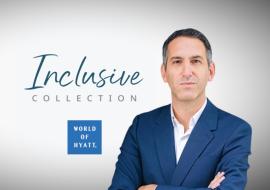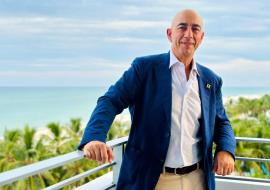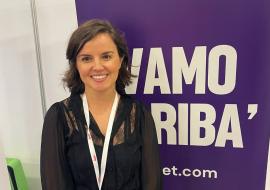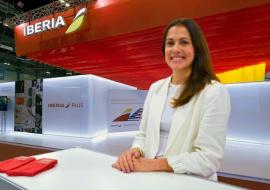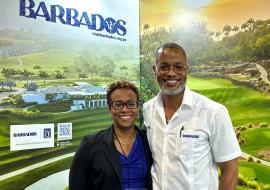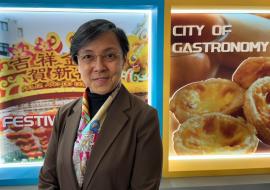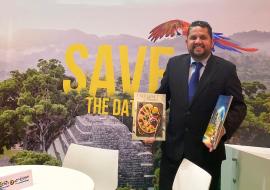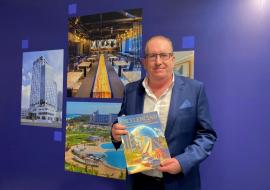“Panama Changed the World and It’s Going to Change You”
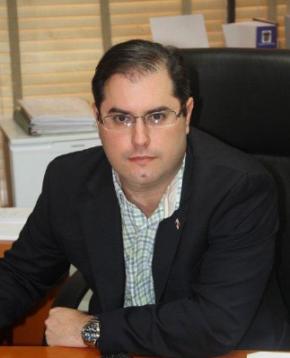
The history of the emergence of the Panamanian isthmus is linked to the change it brought about on planet Earth. It joined pieces of land and separated oceans to modify the geologic history of the world. These are the words of Ernesto Orillac, vice minister of Tourism, who says that coming to the country is going to change tourists. During a recent interview with CND Panama, Mr. Orillac outlined the challenges to be faced by the Tourism Authority in 2014 as he assessed the current management.
Panama has had a spectacular growth in terms of tourism and the figures reflect an increased number of visitors, which surpassed the results reaped last year. What’s next? What are the results of this administration and what is to be done?
We have projected an interesting five-year period; we started a plan that had connectivity as one of the main cores, as well as infrastructure and product. We were working on these elements, developing a strategy, we had to have the airlift increased because we needed more available seats to travel to Panama, and we have precisely worked on this issue, we have successfully increased it with Europe by means of new airlines, and the same happens with Latin America, the Caribbean and North America. The whole idea was having the Hub of the Americas positioned just as it presently is, one of the most important one in Latin America. It’s currently ranked second, and it is boosting tourist arrivals with the expansion of the airport.
Panama has gained momentum and the regional destination has become a global one, thanks to the joint work carried out by private companies, the mass media, everything related to the tourism structure and its image overseas. We have worked on the country brand, a product we received from the Commerce Ministry back in 2009, and we have successfully developed it. There is still a lot to do on this matter, but we keep on working to position this brand.
I’m talking about the promotion because it was very important to work on it and differentiate it from the advertising world. It doesn’t mean that we haven’t advertised the product, but we’ve aimed our efforts at the promotion so we can measure it and keep on working on the markets where we have grown successful. For instance, we developed the Stop Over, the promotion of Atlapa Convention Center for free, promotions on internal tourism, the Tourist Insurance structure, which is a marketing strategy that has helped us to stand out among our closest competitors; we have developed the Destination Marketing Organization DMO and we’ve become a global convention destination.
It’s important to point out that the private sector has developed the hotel infrastructure and the government has worked on the road infrastructure, public transportation, the organization of the city and the country and the construction of airports in different regions. The government and its institutions have worked side by side with the vigorous private sector to fulfill this plan, because the travel industry involves the entire country, every single people living in Panama.
Brand-new products have been created around the Canal, and the Convention Center will become an additional product. New products have been developed near the airports, specifically near the Pacific Ocean with the extension of the Caribbean roads, which I think have waited for too long to be done.
The new 80 law we inked in 2012 was implemented in an effort to foster the harmonic development of the whole national territory.
I strongly believe that we are on the right track, and the numbers are showing it. Several researches were conducted to determine the elements to be positioned in order to promote and advertise the country and we have had positive results. There is a lot to do in terms of brand and positioning. Panama is a fast-growing destination, but we still have to develop some places.
All in all, we’re satisfied with everything we’ve done, but we still have to work, for example, on the Quality Certification. We have developed a pilot plan with over 25 companies in Panama, and we have to take it to a national level so we can get that certification and raise the quality standard in Panama, to improve service and quality.
There is a weak spot in terms of the service; there is something to be strengthened. What is Panama’s Tourism Authority doing on this matter?
I’m more optimistic, if you give the tools to the people willing to do what it takes, Panamanians have qualities that you won’t find in other destinations. Yes, we have to do something when it comes to training our people to obtain the important quality certification. The recertification of hotels, tour operators, travel agencies, tourism guides, who are the ones to give tourists an impression on the destination. That’s what we want to do.
We have invested a lot on education, not only on the education system, but on technical elements. We will keep on working on this matter with all governmental institutions so as to raise the quality level in the country.
Panama has increased the quality in such areas as the Canal and the banking sector. I believe that we can do it and we will succeed. The country has grown too fast, faster than what we expected. We never thought that Panama would reach these levels, and that’s a challenge to be faced.
If we look at the positive side of the story, what visitors say, the experience they take back home if truly encouraging. Panama was chosen by CNN International as one of the top destination to be visited in 2014 and, in the same breath, we were recommended by the New York Times in 2012, by Travel Advisor, by National Geographic. This is a growing and evolving destination, it’s not only about tourism but gastronomy and culture. There are always things to be improved.
What are the challenges the Tourism Authority will have to tackle in 2014?
The Quality Certification is one of the most important challenges. We also want to develop a project of tourism stops along the Pan-American road and the Caribbean roads. There are no restrooms on Panama’s roads and we’re working on it. We have the new Convention Center; we’re working on our land borders, we have to improve them to strengthen the multi-destination with Costa Rica and Central America. The entry to our country is not as good as we’d like and we want to improve the infrastructure. We want to promote our National Parks since 35% of Panama’s territory is made up of protected areas and we want to develop the eco-tourism. We have talked to entities that have done this in Africa, Argentina and other regions of the world and we believe that the model can be adapted. We are to highlight that natural heritage.
Tourism must be a State policy with the contribution of all of us. This sector presently represents 10% of our Gross Domestic Product. It makes over 3,500 million dollars, employs more than 10% of the productive population.
Over the past 4 years the number of visitors has grown in 40%, 100% in terms of the tourism expense, we have developed our infrastructure and doubled the investment.”
Now picture yourself as the voice of the country, you’re Panama, I’m a tourist, what would you tell me to make me fall in love with your country?
Panama is beauty, it has it all. It’s small, but diverse. It’s one-of-a-kind. You can enjoy beaches in the Caribbean Sea and the Pacific Ocean, over 1,800 isles, seven native tribes with rich ethnical culture. It features a diverse cultural tourism, but at the same time it has a vibrant metropolis with world-class gastronomy. It’s a melting pot of races. It’s a young country, with rivers and mountains, these and much more within short distances. Panama is a bridge, the history of the isthmus that came out of the sea and joined two pieces of land. Panama changed the world and it’s going to change you."







